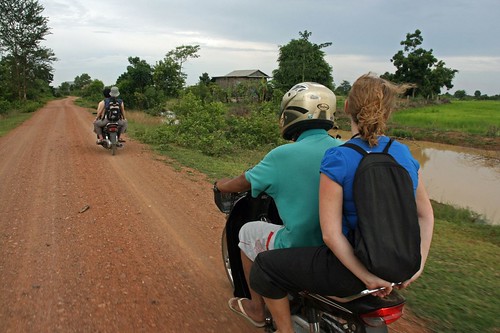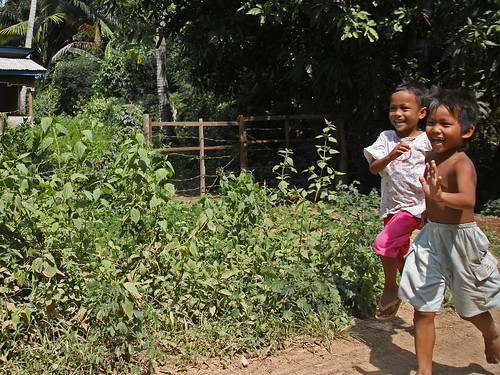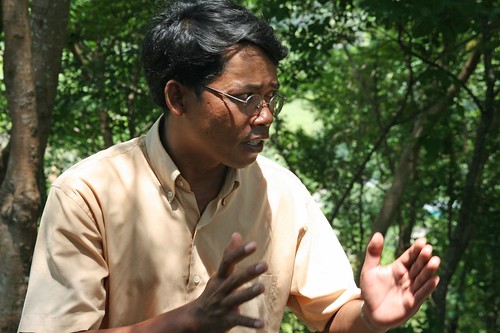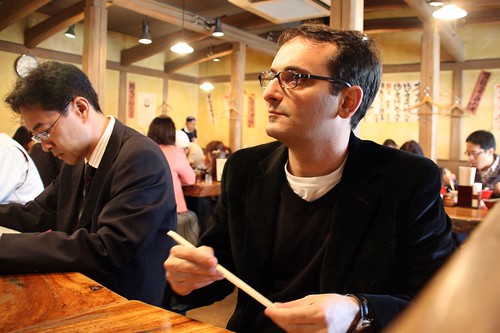Hello! Bye Bye!
Three hundred kilometers from Phnom Phen is Cambodia’s second-largest city, Battambang. With only about 150,000 inhabitants, Battambang will never be mistaken for a world capital. As it is, one might not even recognize Battambang as a city; it is more like a very large village surrounded by fertile countryside. But no one comes to Battambang for the urban experience; people come here to see rural Cambodia.
If you’ve been following my travels, you’ll know that there have been ups and downs, and that the downs often come from the intermittent periods of loneliness that a long-distance traveler is bound to experience. When the editors of Tripmastermonkey.com asked if I would write a story about a tour company called Intrepid Travel, I knew it would be a way to see Cambodia, a fairly difficult country to begin with, and a chance to travel in a group again. What I learned early on was that traveling with a group opens up unexpected opportunities.
One of these opportunities came in the form of a day-long motorbike tour of the Battambang countryside. Each member of the group, seven women, our Khmer guide and myself, hired a motorbike with a driver (for safety and, more importantly, to keep the group traveling at the same speed throughout the day). We held on tight as we rolled out of town and into the country.

Battambang by Motorbike
Our first two stops were, to my delight, related to food. At a roadside hut, we were introduced to sticky rice in bamboo. Sticky rice is mixed with coconut juice and packed into foot-long cylinders of bamboo. The bamboo containers are lined up next to hot coals until the mixture inside is thoroughly cooked. The resulting rice is thick, sticky and sweet, and filling enough for an entire meal.

Sticky Rice in Bamboo
At the next stop, a house a few kilometers down the road, a family was engaged in making rice paper, not the kind for writing, but the kind used to make spring rolls. An old woman crouched in a cloud of steam mechanically spreading a mixture of rice and water on a hot plate, then transferring the wet pancake to a horizontal post. A man then snapped up the wrapper and carefully laid it out on a drying rack. We were told that the family works all day long, in shifts, turning out a few thousand wrappers. For their hard work they might earn what you or I would earn in less than an hour in America.

Making Rice Paper
There are moments when I’m on the road when I look around and know I’m in Asia. The peaceful moments fill me with joy and validate my decision to risk my career for a year on the road. (The unpleasant moments are also enlightening, but harder to swallow.) The journey through the backroads of Battambang was filled with happy visions and moments: farmers leading white oxen across a flooded rice paddy; neon-bright fields of green grasses and crops glowing in the sun; the golden spires of a Buddhist temple glowing on the horizon. However, the moments that brought the most happiness on this day, and continued to provide joy throughout the tour, were the encounters with children.
I don’t know how often foreigners appear on in rural Battambang on motorbikes. I’m sure Intrepid takes groups through there on a regular basis. However often it is, the kids were ecstatic when we’d roll by. They’d sprint out of their houses, whether tumbledown wooden shacks or more solid concrete bungalows, grinning from ear to ear and waving, shouting “Hello! Hello! Hello!” Sometimes they’d yell “Hello! Bye Bye!,” or just “Bye Bye!,” and run after the motorbikes. The enthusiasm that radiated from those children was invigorating and made all of us forget that we were a lot of hot, sweaty travelers, choked by the dust and the grime of unpaved country roads.

Hello!
Unfortunately, Cambodia has the ability to change the mood in a heartbeat. The ultimate destination of the motorbike tour was a mountain (a pimple on the landscape, really) 18 kilometers from the city where the Khmer Rouge used a small temple, Wat Phnom Sampeau, as a prison and a neighboring cave, a killing cave, as a repository for the bodies of their victims. The location is serene today, with beautiful views from the hilltop of the surrounding countryside. In the late 1970’s, however, it was another vision of hell on earth.
Our local guide for the day, Pau, has spent his entire life in Battambang. When he was four years old, the Khmer Rouge regime began it’s reign of terror. Pau, his mother and father and two older siblings were taken from their home and moved to a camp near Phnom Sampeau where about 300 people toiled for the Khmer Rouge. Pau’s father, brother and sister worked in the fields; Pau stayed in the camp with his mother. The whole family suffered from hunger and deprivation, but survived on subterfuge and guile. Pau’s father discovered a store of rice and buried it, cooking in the dark in the middle of the night and feeding his kids handfuls at a time. But that secret stash only lasted for a year.
Eventually, Pau’s brother and sister were taken to another site to build a dam. His father was executed by the Khmer Rouge when someone revealed that he’d once been part of the army. But Pau, his mother and his siblings survived. Hearing his story was a chilling and awful reminder of Cambodia’s recent past. It brought that history to life in a way that our visit to the genocide museum and the killing fields could not.

Pau Tells His Story
Perhaps it was Pau’s story that made those shouts of “Hello! Bye Bye!“ from the rural children so poignant. We’d been told tales of death and misery, but we also witnessed new life and genuine joy. It was an unforgettable day on the road.
+++++
Note: If you clicked Battambang link to Wikipedia at the top of this post, you would have seen two photos. One looked very familiar to me and I clicked on it. I discovered that a Wikipedia contributor has used my photo for the page! I allow non-commercial use of my pictures, so it's cool. I am surprised and flattered!
If you’ve been following my travels, you’ll know that there have been ups and downs, and that the downs often come from the intermittent periods of loneliness that a long-distance traveler is bound to experience. When the editors of Tripmastermonkey.com asked if I would write a story about a tour company called Intrepid Travel, I knew it would be a way to see Cambodia, a fairly difficult country to begin with, and a chance to travel in a group again. What I learned early on was that traveling with a group opens up unexpected opportunities.
One of these opportunities came in the form of a day-long motorbike tour of the Battambang countryside. Each member of the group, seven women, our Khmer guide and myself, hired a motorbike with a driver (for safety and, more importantly, to keep the group traveling at the same speed throughout the day). We held on tight as we rolled out of town and into the country.

Our first two stops were, to my delight, related to food. At a roadside hut, we were introduced to sticky rice in bamboo. Sticky rice is mixed with coconut juice and packed into foot-long cylinders of bamboo. The bamboo containers are lined up next to hot coals until the mixture inside is thoroughly cooked. The resulting rice is thick, sticky and sweet, and filling enough for an entire meal.

At the next stop, a house a few kilometers down the road, a family was engaged in making rice paper, not the kind for writing, but the kind used to make spring rolls. An old woman crouched in a cloud of steam mechanically spreading a mixture of rice and water on a hot plate, then transferring the wet pancake to a horizontal post. A man then snapped up the wrapper and carefully laid it out on a drying rack. We were told that the family works all day long, in shifts, turning out a few thousand wrappers. For their hard work they might earn what you or I would earn in less than an hour in America.

There are moments when I’m on the road when I look around and know I’m in Asia. The peaceful moments fill me with joy and validate my decision to risk my career for a year on the road. (The unpleasant moments are also enlightening, but harder to swallow.) The journey through the backroads of Battambang was filled with happy visions and moments: farmers leading white oxen across a flooded rice paddy; neon-bright fields of green grasses and crops glowing in the sun; the golden spires of a Buddhist temple glowing on the horizon. However, the moments that brought the most happiness on this day, and continued to provide joy throughout the tour, were the encounters with children.
I don’t know how often foreigners appear on in rural Battambang on motorbikes. I’m sure Intrepid takes groups through there on a regular basis. However often it is, the kids were ecstatic when we’d roll by. They’d sprint out of their houses, whether tumbledown wooden shacks or more solid concrete bungalows, grinning from ear to ear and waving, shouting “Hello! Hello! Hello!” Sometimes they’d yell “Hello! Bye Bye!,” or just “Bye Bye!,” and run after the motorbikes. The enthusiasm that radiated from those children was invigorating and made all of us forget that we were a lot of hot, sweaty travelers, choked by the dust and the grime of unpaved country roads.

Unfortunately, Cambodia has the ability to change the mood in a heartbeat. The ultimate destination of the motorbike tour was a mountain (a pimple on the landscape, really) 18 kilometers from the city where the Khmer Rouge used a small temple, Wat Phnom Sampeau, as a prison and a neighboring cave, a killing cave, as a repository for the bodies of their victims. The location is serene today, with beautiful views from the hilltop of the surrounding countryside. In the late 1970’s, however, it was another vision of hell on earth.
Our local guide for the day, Pau, has spent his entire life in Battambang. When he was four years old, the Khmer Rouge regime began it’s reign of terror. Pau, his mother and father and two older siblings were taken from their home and moved to a camp near Phnom Sampeau where about 300 people toiled for the Khmer Rouge. Pau’s father, brother and sister worked in the fields; Pau stayed in the camp with his mother. The whole family suffered from hunger and deprivation, but survived on subterfuge and guile. Pau’s father discovered a store of rice and buried it, cooking in the dark in the middle of the night and feeding his kids handfuls at a time. But that secret stash only lasted for a year.
Eventually, Pau’s brother and sister were taken to another site to build a dam. His father was executed by the Khmer Rouge when someone revealed that he’d once been part of the army. But Pau, his mother and his siblings survived. Hearing his story was a chilling and awful reminder of Cambodia’s recent past. It brought that history to life in a way that our visit to the genocide museum and the killing fields could not.

Perhaps it was Pau’s story that made those shouts of “Hello! Bye Bye!“ from the rural children so poignant. We’d been told tales of death and misery, but we also witnessed new life and genuine joy. It was an unforgettable day on the road.
+++++
Note: If you clicked Battambang link to Wikipedia at the top of this post, you would have seen two photos. One looked very familiar to me and I clicked on it. I discovered that a Wikipedia contributor has used my photo for the page! I allow non-commercial use of my pictures, so it's cool. I am surprised and flattered!



0 Comments:
Post a Comment
<< Home